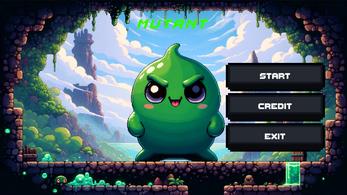Mutant
Mutant
Team ELK
Made For UCSC CMPM125 Final Project
Game operation instructions:
Use the arrow keys to move and the x key to attack. Press and hold the Tab Key to bring up the transformation interface, and click the corresponding number keys to complete the transformation
Team Member:
Zexuan Li (Player character and animation design)
Zhuo Chen (Enemy interaction and AI design)
Guixiang Li (UI and sound effect design)
Lizhuoyuan Wan (Scenario design)
Description:
You will play as a mutant slime, use your transformation skills to transform into various creatures and overcome a series of challenges
Theme:
Fight fire with fire
Design goals:
1. Show the theme of our game through the mechanism of transforming into enemies, and incorporate gameplay related to this mechanism into the game.
2. Create a relaxed and pleasant gaming atmosphere and give players a relaxing gaming experience.
3. Integrate basic level artificial intelligence into the game to provide players with a basic but not boring combat experience.
Postmortem Blog:
Reflecting on our entire development process, despite some time constraints, we largely followed our planned schedule. We achieved many of our initial design goals, such as the transformation mechanism, enemy AI with patrolling and unique attack mechanics, level mechanisms built around the transformation concept, and corresponding UI design. Some aspects weren't as perfect as anticipated, but they were all realized in some form. However, our biggest regret was cutting an important enemy from our game, the final scene's boss. Our original plan was for the player to battle a large underground boss after falling from a height in the second level. In this fight, players needed to skillfully use the transformation mechanism to defeat the enemy. We even added small caves accessible only by the slime form in the map, intended as spots where the player could hide from the boss's screen-wide attacks. Due to time constraints, we had to cut this feature, making the third level about facing numerous smaller enemies. This decision admittedly reduced the visual impact of the third level and made the game's ending somewhat bland. Although it was a necessary choice, removing it was regrettable for every member of the team.
Of course, there were many outstanding parts of our project. For instance, Zexuan was responsible for creating fun transformation mechanics and animations, which allow players to switch between different characters and produce different interactive effects in the scene. while Chen designed very intelligent behaviors for the enemy AI. For example, archers would quickly move to avoid attacks when enemies approached, and soldier units would leap high to dodge incoming arrows. Lizhuoyuan's scenario design was equally impressive, the style of the scene remains highly consistent and has a good interactive effect with the transformation mechanism.. Guixiang added rich UI elements and vivid sound effects, making the game more engaging. Every team member made significant contributions to the development, which is a source of pride for us all.
Behind these, we encountered many challenges during development. A notable issue was between our transformation mechanism and enemy patrol mechanics. Since our transformation essentially involved destroying the current character on-screen and instantly creating a transformed character, it sometimes caused the enemy AI to lose its target, resulting in unpredictable behavior. This issue took us a long time to resolve. Eventually, we fixed it by continuously tracking the current character in the transformation manager, ensuring that the enemies always obtained this reference every frame. Although errors still occasionally occurred, this solution prevented the enemies from going haywire in the game. Additionally, as a group project, we inevitably faced some communication and coordination issues. However, every team member maintained a positive attitude towards resolving these issues, ensuring they didn't affect our group atmosphere or relationships.
Given more time, we would have developed two features we initially planned but ultimately abandoned. First was the final boss, which, as mentioned, had a designed scene and mechanics but was dropped due to time constraints. The second was the new input system. We had already used it for most character controls but lacked time to implement UI-related interactions, leading to its abandonment, which was regrettable for everyone. There were also many level designs and mechanical details we hoped to implement but had to forsake due to time pressure. We believe an additional week would have allowed us to further refine our game, bringing it closer to our original vision.
This production experience taught us a lot. In terms of creation, we learned many skills related to player character and enemy interactions, as well as level design experience. From a project management perspective, we gained skills in communication and time management. We'll reflect on this experience, turning it into new knowledge for future productions. With this experience, we're confident we can create even better games in the future.
